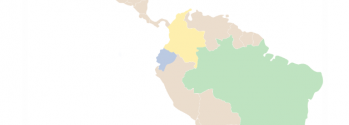In ideologies of Colombian nationality, blackness is more important than in Mexico, but less so than in Brazil. There is a small indigenous population (3.4 percent), but, as in Brazil, it figures large in ideas about the nation and its history – and in the multiculturalist reforms that followed from constitutional reform in 1991. A powerful trope in images of the Colombian nation is the idea of internal difference, with the country often being talked of as a “country of regions”, each with a supposedly particular often racialised identity. Whiteness and mestizo-ness are often associated with each other and located stereotypically in the highlands, whereas blackness is stereotypically associated with the Pacific and Caribbean lowland coastal regions; indigenousness is seen as both highland (Andean) and lowland (Amazonian) and is stereotyped as rural. In contrast to Brazil, mestizos are more likely to be assimilated to whiteness than to blackness.
Colombia has the second largest population of Afrodescendants in Latin America, after Brazil; in the 2005 census Afro-Colombians were 10.5 percent of the national total. Yet before the 1990s, when multiculturalist laws came onto the statute books, Afro-Colombian social mobilization was not well developed and, indeed, many academics and activists bemoaned the fact that Afro-Colombians were “invisible” in the eyes of the state and academic disciplines. From 1991, however, the country has built up a comprehensive array of legislation aimed at Afrodescendant peoples, covering special land titles for “black communities” (as defined by Law 70 of 1993), ethno-education programs in schools, university places reserved for candidates from black communities, representation on committees and decision-making bodies at various levels of the state, a special Directorate of Black Community Affairs, and two seats in the Chamber of Representatives of the Congress reserved for candidates representing black communities. Indigenous communities (3.4 percent of the national total in the 2005 census) have had a longer history of attention from the state, but legal provision for them has also consolidated after 1991: legislation has now resulted in about 30% of the national territory being placed into indigenous reserves, which also receive fiscal transfers from the state. Reforms have also put indigenous senators into Congress and indigenous students into university places with funding reserved for indigenous applicants.
These policies directed at rights for indigenous and black minorities are beginning to open up increasing space for actions against racism, in some cases sponsored by the state and NGOs (e.g. the 2009 National Campaign Against Racism, supported by the Vice-President, or the NGO Chao! Racismo); there is an Observatory of Racial Discrimination and the numerous organisations in the black and indigenous social movements address issues of racism to varying degrees. The focus here is largely on Afro-Colombians and anti-black racism. In Colombia, the idea of anti-indigenous racism still has little traction – less than in Ecuador, but arguably more than in Brazil, probably because of the larger and more active indigenous social movement.
Worryingly, exclusion of racialized minorities now operates more than ever through violence and displacement. Violence has certainly targeted such minorities in the past: black and indigenous groups were caught up in the cross-fire of state, guerrilla and paramilitary violence before the 1991 reforms. However, one anthropologist characterized areas of the Pacific coastal region as a “haven of peace” before the early 1990s, relatively immune from the conflicts wracking central areas of the country, and able to resolve local disagreements without resorting to violence. From the 1990s, however, violence spread into the Caribbean coastal region, where significant black and indigenous populations live. In particular, violence has spread into the Pacific coastal region, with its predominant Afro-Colombian population and with significant indigenous populations too. The region became a target for guerrilla activity and soon after for military incursions. Paramilitary forces, using tactics of terror and coercion, displaced large numbers of people – severely undermining many of the newly-gained collective land titles. The Consultancy on Human Rights and Displacement (Consultoría para los Derechos Humanos y el Desplazamiento, CODHES) estimates 4.1 million Colombians were forced from their homes between 1999 and 2012. Of these people, it was estimated in 2009 that 24% belonged to some ethnic group, with 17% being Afro-Colombians and 6.5% indigenous.



